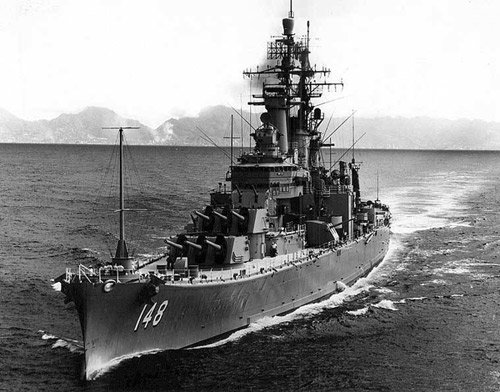Des Moines-class (CA-134)
Summary
| Origin country | 🇺🇸 United States |
| Category | Cruiser |
| Subtype | Heavy cruiser (World War II) |
| Manufacturer | Newport News Shipbuilding |
| Year commissioned | 1948 |
Description
The USS Des Moines (CA-134) served as the lead ship in the Des Moines-class of heavy cruisers for the United States Navy. She was notable for being the first navy ship to be fitted with the revolutionary auto loading Mark 16 8-inch/55 caliber guns. Commissioned in 1948, the second vessel to bear the name after Iowa's capital, she was launched two years prior by Bethlehem Steel at their Fore River Shipyard in Quincy, Massachusetts. Mrs. E. T. Meredith Jr. sponsored the launch.
Designed with advanced naval capabilities for its time, USS Des Moines featured state-of-the-art armament, most prominently the semi-automatic Mark 16 8-inch turrets. These guns represented a significant leap in naval firepower technology. The ship was also equipped to carry the new Sikorsky HO3S-1 utility helicopters, which replaced the traditional seaplanes.
Throughout her operational history, USS Des Moines was tasked with various duties to maintain navy readiness in response to defense and foreign policy requirements. Operating initially from Newport, Rhode Island, and later from Norfolk, Virginia, she participated in numerous exercises in the Caribbean, East Coast, and North Atlantic, and sailed frequently to the Mediterranean Sea. Between 1949 and 1957, her Mediterranean deployments were an annual occurrence, with her taking on the role of flagship for the 6th Task Fleet (later 6th Fleet). During this time, she engaged in NATO exercises, midshipmen summer training cruises, and provided a robust American naval presence in strategic regions, contributing notably during the Suez Crisis of 1956 and the Lebanon crisis of 1958.
USS Des Moines was decommissioned in 1961 and placed in the mothball fleet. An evaluation in 1981 determined that despite her potential, modernization for the proposed 600-ship Navy under the Reagan Administration would be too costly, leading to a decision against her reactivation. The ship remained on the reserve list until 1993, when efforts to preserve her as a museum ship failed. She was sold for scrap in 2005, with dismantling completed by July 2007. Despite this, parts of USS Des Moines live on; various elements of the ship, including the bell, nameplate, plaque, and one of her anchors have been preserved and displayed at different locations, including at the USS Salem museum, the remaining Des Moines-class cruiser and museum ship.
Technical specifications
| Des Moines | |
|---|---|
| Displacement | 15422 tons |
| Range | 19000 km at 15 knots |
| Crew | 1799 members |
| Width | 23.32 m (76.5 ft) |
| Length | 210.0 m (689.0 ft) |
| Propulsion | 4 General Electric turboprops with a total power of 120,000 hp - 4 propellers |
| Armament | 9 203 mm guns + 12 127 mm guns + 24 76.2 mm guns + 24 20 mm AA guns. |
| Maximum speed | 33 knots |
Photo of Des Moines class
